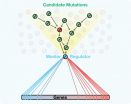The new findings, made by a team of scientists from Beth Israel Deaconess Medical Center (BIDMC) and the Salk Institute, are described in the October 9 online issue of the journal Cell.
"We were blown away to discover this completely new class of molecules," says senior author Barbara Kahn, MD, Vice Chair of the Department of Medicine at BIDMC and the George R. Minot Professor of Medicine at Harvard Medical School. Named fatty acid hydroxyl fatty acids, or FAHFAs, these new molecules are in fat cells as well as other cells throughout the body. They now join a small group of fatty acids known to benefit health, which also include omega-3 fatty acids found in fish oil.
"Based on their biology, we can add FAHFAs to the small list of beneficial lipids," says co-senior author Alan Saghatelian, PhD, a professor in the Clayton Foundation Laboratories for Peptide Biology at the Salk Institute in La Jolla, Calif. "These lipids are amazing because they can also reduce inflammation, suggesting that we might discover opportunities for these molecules in inflammatory diseases, such as Crohn's disease and rheumatoid arthritis, as well as diabetes."
Unlike omega-3 fatty acids, which are not made in mammals, FAHFAs are actually produced and broken down inside the human body. "This important feature gives FAHFAs an advantage in terms of therapeutic development because we can potentially modify the rate of production and breakdown throughout the body," notes Kahn. "Because we can measure FAHFA levels in blood, low levels may turn out to be an early marker for the risk of developing type 2 diabetes. Consequently, if restoring FAHFA levels in insulin resistant individuals proves to be therapeutic, we may potentially be able to intervene before the development of frank diabetes."
Glut-4 Mouse Model Is Key to Discovery
Key to the new findings was an animal model first created in the Kahn laboratory in the early 1990s. "Our adipose-specific GLUT-4 overexpressing mouse model [AG4OX] was initially designed after we observed that humans who are insulin resistant – and therefore more prone to develop diabetes and metabolic disease – have lower levels of the GLUT-4 glucose transporter molecules in their fat cells," says Kahn. "To our surprise, overexpression of GLUT-4 in fat was sufficient to increase glucose tolerance and protect the mice against diabetes, even when the animals were obese."
Over the years, the investigators have consistently observed that these mice have elevated fatty acids, which is generally associated with insulin resistance and glucose intolerance. But the AG4OX mice are sensitive to insulin and able to control blood sugar.
Therefore, to find out more about these fatty acids, Kahn collaborated with Saghatelian to conduct advanced lipodomic analyses of the AG4OX mice compared to normal littermates.
"Mass spectrometry lipodomics technology enables us to quantify hundreds of lipids from a biological sample by using the molecular weight of a lipid as a means to determine its presence in a cell or tissue," explains Saghatelian. When the investigators examined the lipodomics results, they discovered a group of four lipids that were elevated 16-18-fold in the AG4OX mice, but not in the normal mice. A search of existing lipid databases to learn the identity (i.e. the structure) of these lipids turned up empty, so the investigators set out to further probe these mysterious molecules.
"Once we had the molecular formula from our lipodomics data, we knew that these lipids belonged to a novel family, and we were then able to use tandem mass spectrometry [MS/MS] and chemical synthesis to identify their structures," explains Saghatelian. Through this approach, they discovered that the molecules consisted of a hydroxyl fatty acid and fatty acid that were joined by an ester bond.
"I've been conducting these analyses for more than a decade and FAHFA is one of only two new classes of lipids that we've uncovered," he notes. "This is a rare discovery."
The authors then went on to conduct a series of experiments. They discovered that feeding the mice extra FAHFAs resulted in a rapid and dramatic drop in blood sugar and rise in insulin. They also looked at FAHFA levels in human fat and plasma, studying samples from individuals who were known to be insulin resistant and at high risk for developing diabetes. In this case, FAHFA levels were found to be 50 to 75 percent lower than levels in people with normal insulin sensitivity, suggesting that changes in FAHFA levels might be contributing to diabetes.
The team also identified GPR-120, the cellular receptor that FAHFAs bind to. "When FAHFAs bind to GPR-120, they are able to control how much glucose is taken up into fat cells," says Kahn. "The receptor may also be responsible for the effects of the novel lipids to reduce widespread macrophage activation, which is associated with obesity and with inflammatory diseases.
"The discovery of FAHFAs provides important new insights underlying metabolic and inflammatory diseases, and, of critical importance, offers viable new treatment avenues that we hope to be able to test in clinical trials," says Kahn. "This is of critical importance as rates of obesity and type 2 diabetes remain at epidemic proportions worldwide."
INFORMATION:
In addition to Kahn and Saghatelian, coauthors include BIDMC investigators Mark M. Yore and Ismail Syed (co-first authors), Pedro M. Moraes-Vieira, Mark A. Herman, Jennifer Lee, Odile D. Peroni, and Abha S. Dhaneshwar; Tejia Zhang and Shili Chen of the Salk Institute; Edwin A. Homan of Harvard University; Rajesh Patel and Timothy E. McGraw of Weill Cornell Medical College; and Ann Hammarstedt and Ulf Smith of the University of Gothenburg, Sweden.
This work was supported, in part, by National Institutes of Health grants R37DK43051, P30 DK57521; R01 DK098002. Other funding is from the JPB Foundation, the Searle Scholars Award, Burroughs Wellcome Fund CABS, Sloan Foundation Fellowship, and grants from the Harvard Training Program in Nutrition and Metabolism.
Beth Israel Deaconess Medical Center is a patient care, teaching and research affiliate of Harvard Medical School, and currently ranks third in National Institutes of Health funding among independent hospitals nationwide.
BIDMC is in the community with Beth Israel Deaconess Hospital-Milton, Beth Israel Deaconess Hospital-Needham, Beth Israel Deaconess Hospital-Plymouth, Anna Jaques Hospital, Cambridge Health Alliance, Lawrence General Hospital, Signature Healthcare, Beth Israel Deaconess HealthCare, Community Care Alliance, and Atrius Health. BIDMC is also clinically affiliated with the Joslin Diabetes Center and Hebrew Senior Life and is a research partner of Dana-Farber/Harvard Cancer Center. BIDMC is the official hospital of the Boston Red Sox. For more information, visit http://www.bidmc.org.



